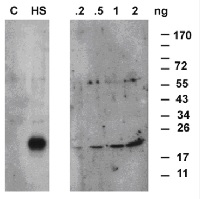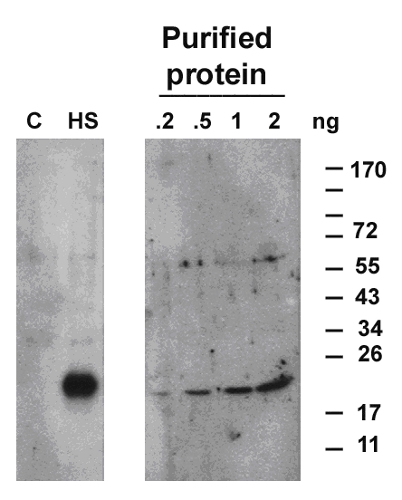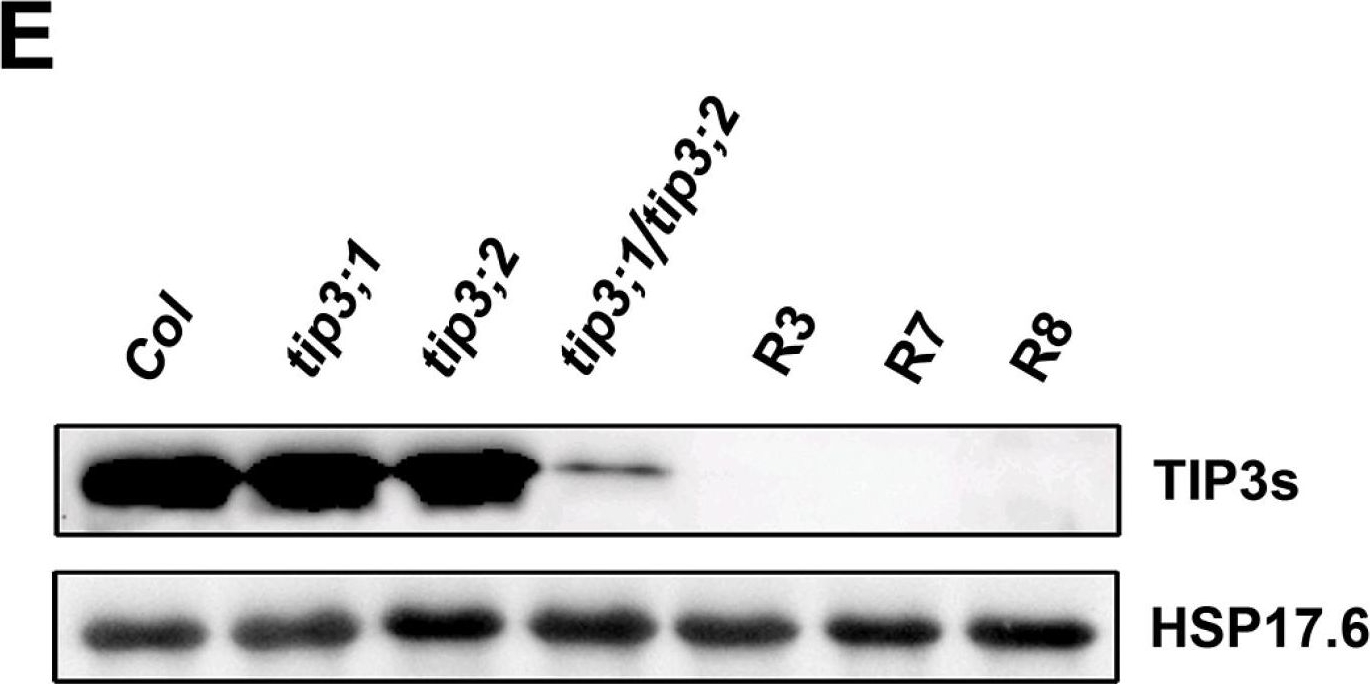1

Anti-HSP17,6 | Cytosolic class I heat shock protein 17,6 (chicken antibody)
AS08 284 | Clonality: Polyclonal | Host: Hen | Reactivity: Arabidopsis thaliana
- Product Info
-
Immunogen: Recombinant protein derived from a sequence Arabidopsis thaliana HSP17.6 Ci (class one) UniProt: P13853, TAIR: At1g53540
Host: Chicken Clonality: Polyclonal Purity: Purified total IgY (chicken egg yolk immunoglobulin) in PBS pH 8. Contains 0.02 % sodium azide. Format: Liquid Quantity: 200 µl Storage: Store at 4°C; make aliquots to avoid working with a stock. Please remember to spin the tubes briefly prior to opening them to avoid any losses that might occur from material adhering to the cap or sides of the tube. Tested applications: Western blot (WB) Recommended dilution: 1 : 1000 (WB) Expected | apparent MW: 17.6 kDa - Reactivity
-
Confirmed reactivity: Arabidopsis thaliana Not reactive in: No confirmed exceptions from predicted reactivity are currently known - Application Examples
-
Application example

10 µg of total protein from (C) Arabidopsis thaliana WT, non-stressed, (HS) Arabidopsis thaliana WT stressed at 38ºC were separated on 15% SDS-PAGE and blotted 1h to nitrocellulose (Biorad). Blots were incubated in the primary antibody at a dilution of 1: 1 000 for 1h at room temperature with agitation and a secondary HRP-conjugated antibody (1: 10 000).
Application examples: 
Reactant: Arabidopsis thaliana (Thale cress)
Application: Western Blotting
Pudmed ID: 26019256
Journal: J Exp Bot
Figure Number: E
Published Date: 2015-08-01
First Author: Mao, Z. & Sun, W.
Impact Factor: 6.088
Open PublicationIdentification of tip3;1 and tip3;2 T-DNA insertion mutants and three TIP3;1-RNAi transgenic lines (TIP3;1-RNAi/tip3;2) in the tip3;2 mutant background. (A) Schematic representation of the tip3;1 and tip3;2 T-DNA insertion mutant lines. A triangle indicates the position of the T-DNA insertion, and the arrow indicates its orientation. The genomic sequences corresponding to the coding region (black boxes), untranslated region (grey boxes), and introns (black lines) are indicated. The positions of the primers (31LP, 31RP, 32LP, and 32RP) used for PCR analysis of the tip3;1 and tip3;2 T-DNA insertion mutants, respectively, are also indicated. (B) PCR analysis of genomic DNA of Col, tip3;1, tip3;2, and tip3;1/tip3;2. LP, left primer; RP, right primer; LB, T-DNA left border primer. (C) Schematic representation of the construct used for the suppression of TIP3;1 in Arabidopsis seeds. RNAi technology was used with a segment of the TIP3;1 gene driven by the seed-specific TIP3;1 promoter. (D) qRT-PCR analysis of TIP3;1, TIP3;2, and ACT7 transcript abundance in mature seeds of Col, mutants, and RNAi lines. PP2A was used as the endogenous control, and the transcript abundance of TIP3;1, TIP3;2, and ACT7 was quantified by comparisons with that of PP2A. Values are means ±SD, n=3. (E) Immunoblot analysis of TIP3s in mature seeds from Col, tip3 mutants, and three TIP3;1-RNAi/tip3;2 transgenic lines (R3, R7, and R8). HSP17.6, which is expressed in mature seeds, was used as a loading control. (This figure is available in colour at JXB online.)
- Additional Information
-
Additional information: Total IgY concentration is 32.2 µg/µl Additional information (application): There are six total class I genes, Essentially this antibody might react to some extent with all of them, But does not react with class II, organelle, or any other shsp classes - Background
-
Background: Hsp17.6 belongs to a family of class I of a small heat shock proteins. They are induced once a plant cells are stressed by an increased temperature. The way small hsp proteins are protecting a living cell are not fully understood. They seem to be involved in chaperone functions by protecting other proteins from irreversible denaturation. Small hsp function also in a late seed maturation process.
- Product Citations
-
Selected references: Mao and Sun (2015). Arabidopsis seed-specific vacuolar aquaporins are involved in maintaining seed longevity under the control of ABSCISIC ACID INSENSITIVE 3. J Exp Bot. 2015 May 26. pii: erv244. - Protocols
-
Agrisera Western Blot protocol and video tutorials
Protocols to work with plant and algal protein extracts - Reviews:
-
This product doesn't have any reviews.



